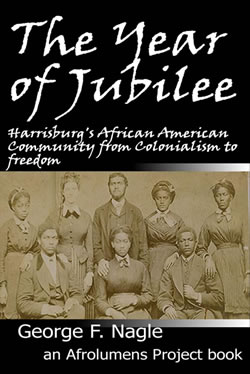
a book about Harrisburg...
by George F. Nagle
Study Areas:
Chapter
Six (continued)
No Haven on Free Soil
On Claim of the Party
The asylum offered by Pennsylvania to fugitive slaves was about to end, ironically, due to the state’s efforts to protect blacks within its borders. Nothing in the Gradual Abolition Act was meant to protect slaves fleeing into Pennsylvania from other states, although that had been the practical result in the first few years after passage of that act, as hundreds of slaves from nearby states sought shelter in Philadelphia and the southern border counties of York and Lancaster. Southern slaveholders seeking the return of their runaway slaves relied upon rewards as an incentive for local persons to assist in the capture. When that failed, either they had to travel in person into Pennsylvania, or send hired slave catchers to retrieve the runaway. Their right to do this was guaranteed under the fugitive slave clause of the Constitution, which stated “No person held to Service or Labour in one State, under the Laws thereof, escaping into another, shall, in Consequence of any Law or Regulation therein, be discharged from such Service or Labour, but shall be delivered up on Claim of the Party to whom such Service or Labour may be due.”
Unfortunately, the Constitution did not specify how such deliverance of a fugitive slave was to be accomplished, depending instead upon the good faith cooperation between states when such situations arose. Good faith cooperation between Pennsylvania and its southern neighbors would prove to be very elusive, however, in part because of the increasing divide on how slavery was viewed between northern and southern states, but also largely due to the escalating number of slaves fleeing across the Mason-Dixon line. In passing the Gradual Abolition Act, Pennsylvania had unwittingly propped open the door to southern freedom seekers, but a dispute over the rights of a man freed by that act would lead to the legal slamming shut of that door.
By law, Pennsylvania slaves not registered by their owners by the end of October 1780 would be declared legally free. This provision of the new law did indeed free many hundreds of persons, including a man in Washington County, Pennsylvania named John who was the property of a slaveholder by the name of Davis. John’s owner moved from Maryland into Pennsylvania, bringing his slave with him, into a region that had been claimed by both Pennsylvania and Virginia. Although the boundary had been set by the time the new slavery abolition law took effect, the border was not ratified by the Pennsylvania legislature until 23 September 1780, so the residents of this area were given until the last day of 1782 to register without penalty any slaves that they held on the day the boundary was legally recognized. John’s master, for some reason, failed to do so, and the enslaved man became nominally free.
He continued to live as a slave, though, in the Davis household in Washington County until 1788, when his former owner took him to Virginia and illegally hired him out as a slave to man named Miller. When they learned of his fate, several of John’s friends in Washington County traveled to Virginia, located him, and brought him back to Pennsylvania, and freedom. Not long after that, in May 1788, Miller hired three Virginia men to retrieve John. The men tracked him back to the town of Washington, in Washington County, kidnapped him from that town, and brought him back to the man who claimed original ownership, Mr. Davis. In retaliation, John’s friends had charges of kidnapping filed against the three Virginians, and a Pennsylvania judge indicted them in absentia. Little happened in this case for nearly three years, as John remained in slavery, having been since sold by Davis to another slaveholder, and two of the three kidnappers remained free in Virginia.
Concern for the safety of free blacks in Pennsylvania motivated members of the Pennsylvania Abolition Society to petition Pennsylvania Governor Thomas Mifflin for action. Mifflin sent a letter to Virginia Governor Beverly Randolph, requesting the extradition of the three men under indictment in Pennsylvania for the kidnapping of John.59 It appeared that the two states were on the path to resolving the issue in a civil and orderly manner according to the extradition clause of the Constitution. A quick and peaceable resolution of the case, with the kidnappers returned to Pennsylvania for trial on felony charges, would have set a significant precedent that conceivably would have assured the safety and rights of all free African Americans in northern states. What happened instead was a complete breakdown of cooperation between Pennsylvania and Virginia in this case, and the entrenchment of ill feelings toward each other, as each state perceived that it was defending a vested interest in any case involving the dirty business of slave catching.
Instead of allowing an extradition of the three slave catchers, Pennsylvania Governor Mifflin’s request was placed by Virginia Governor Randolph before his state attorney general, James Innes, who advised against extradition because he felt the crimes committed by the slave catchers, under Virginia law, did not rise to the level of felony. Innes asserted that the kidnapping of a free black person amounted to little more than trespass or a breach of the peace. Furthermore, Innes believed the three men had broken no federal or Virginia laws, and therefore could not be arrested within the state for return to Pennsylvania. Virginia’s governor refused the extradition then, based upon this advice from his attorney general.
Pennsylvania Governor Mifflin, highly dissatisfied with this response, took the matter directly to President George Washington, requesting congressional clarification on what he saw as a deliberate flouting of clearly stated constitutional protections. Washington had the matter reviewed by the United States Attorney General, Edmund Randolph, who found that both Pennsylvania Governor Mifflin and Virginia Governor Randolph had made both legal and logical errors in dealing with the extradition. Not wanting to take every single interstate dispute before congress, Washington urged the two state governors to correct their mistakes and resolve the issue between them, but as the months passed, the issue became more inflamed as pro-slavery and anti-slavery advocates transformed it from a dispute over the extradition of criminal suspects between neighboring states, to a referendum on the right to own slaves.
Virginians argued that their slaves were constantly being “seduced” by Pennsylvanians to flee their masters and cross into Pennsylvania, where they were hidden and protected from return. Pennsylvanians argued that southern slaveholders regularly rampaged through small border towns seeking runaway slaves, terrorizing and threatening local free blacks and bullying local anti-slavery proponents. Free blacks were also being kidnapped, Pennsylvania charged, and forced into slavery in southern states. It was clear to President Washington that the dispute, permeated with such highly-charged and emotional rhetoric, was going nowhere, so he instructed a congressional committee to construct a bill that would provide the mechanism not only for the lawful return of fugitives from justice, but also for the rendition of fugitives from labor, the popular euphemism for slaves.60 Slavery, which had already been a sticking point between north and south in the production of the Constitution, had now become a prime source of friction along the border between slaveholding and free states, and the source of interstate crimes. Washington saw no way to separate the two issues.
In the coming months, the Fugitive Slave Act would be primarily shaped in the Senate, where the committee charged with its creation was composed mostly of southern Senators. In its first version, the bill required only a single deposition from a claimant to turn an alleged fugitive slave over for rendition back to the slave state, and allowed for no formal hearings on behalf of the alleged runaway before a local judge. It also allowed for heavy fines on anyone who harbored fugitive slaves, refused cooperation in the capture, or tried to interfere with the rendition process.
The language was so loosely written that northerners who attempted to defend blacks whom they believed to be free, or employers who unwittingly hired a fugitive slave, could be financially ruined by fines and lawsuits. Opposition by northern Senators to the more flagrantly injurious portions of this bill prompted a series of amendments that provided for hearings before judges or local magistrates and the supply of proof, whether oral depositions or legal documentation, before the judge could issue a writ of removal for the fugitive slave. It also provided for trials in cases where the alleged fugitive had lived in a free state for a specific number of years. However these precautions designed to protect free blacks, were offset by the elimination of the requirement that claimants first secure a warrant from the local judge before seizing a fugitive slave. This version of the bill also permitted slave owners to use agents to legally pursue, seize and remove fugitive slaves in their name.
When it appeared that this version of the bill would please no one, it having objectionable provisions to both north and south, further last minute changes were made. Southern Senators successfully changed the requirements for penalties for anyone who would merely “obstruct or hinder” the claimant or agent in the apprehension of a fugitive slave, from the previously stated requirement that they “knowingly and willfully obstruct” such apprehension. This softening of the requirements for penalties gave more power to the slave hunters to oppose anyone who stood in their way. Northern Senators were successful in removing the requirement that local law enforcement officials arrest and detain the fugitive slave on the order of a claimant, thus removing them from the detested role of slave catcher.
Further debate on the Senate bill resulted in another southern victory, in the removal of language requiring a trial for alleged fugitives who insisted they were free because they were born in a free state, or had resided there a long time. Also, southerners succeeded in having state courts added to federal courts as the venues in which they could bring suit against anyone who “hindered” their capture of a runaway, thus giving more bite to the prohibitions against opposing anyone attempting the capture of a fugitive slave.
The
Senate passed the bill and sent it to the House of Representatives,
which in turn passed it with few significant changes. George Washington
signed it on 12 February 1793, and the Fugitive Slave Act became the
law of the land.61 In
the end, Pennsylvania’s goal of safeguarding its growing free
black population from kidnapping was undermined by the need of slaveholding
states to protect the institution of slavery within their borders.
The simple request by Governor Mifflin for the extradition of three
kidnappers resulted in exactly the thing everyone had hoped to avoid:
a tortuous procedure of congressional debate, bills, and amendments
that ultimately removed most of the protections that the Keystone State
had sought to secure. With the passage of the Fugitive Slave Law of
1793, Pennsylvania lost not only its sovereignty in dealing with slave
catchers who regularly invaded its border and interior counties; it
lost its brief role as a haven for freedom seekers.
Notes
59. Paul Finkelman, Slavery and the Founders: Race and Liberty in the Age of Jefferson, 2nd ed. (New York: M. E. Sharpe, 2001), 81-86; Pennsylvania Archives, 9th ser., 1791.
60. Finkelman, Slavery and the Founders, 86-90.
61. Ibid., 90-98.
Caution: Copyrighted material. Published September 2010.
© 2010 George F. Nagle
This is the first in a series of books from the Afrolumens Project. Drawing on a large number of sources, and making good use of the treasure trove of information on the pages of the Afrolumens Project, this is the first truly comprehensive history of Harrisburg's African American community.

